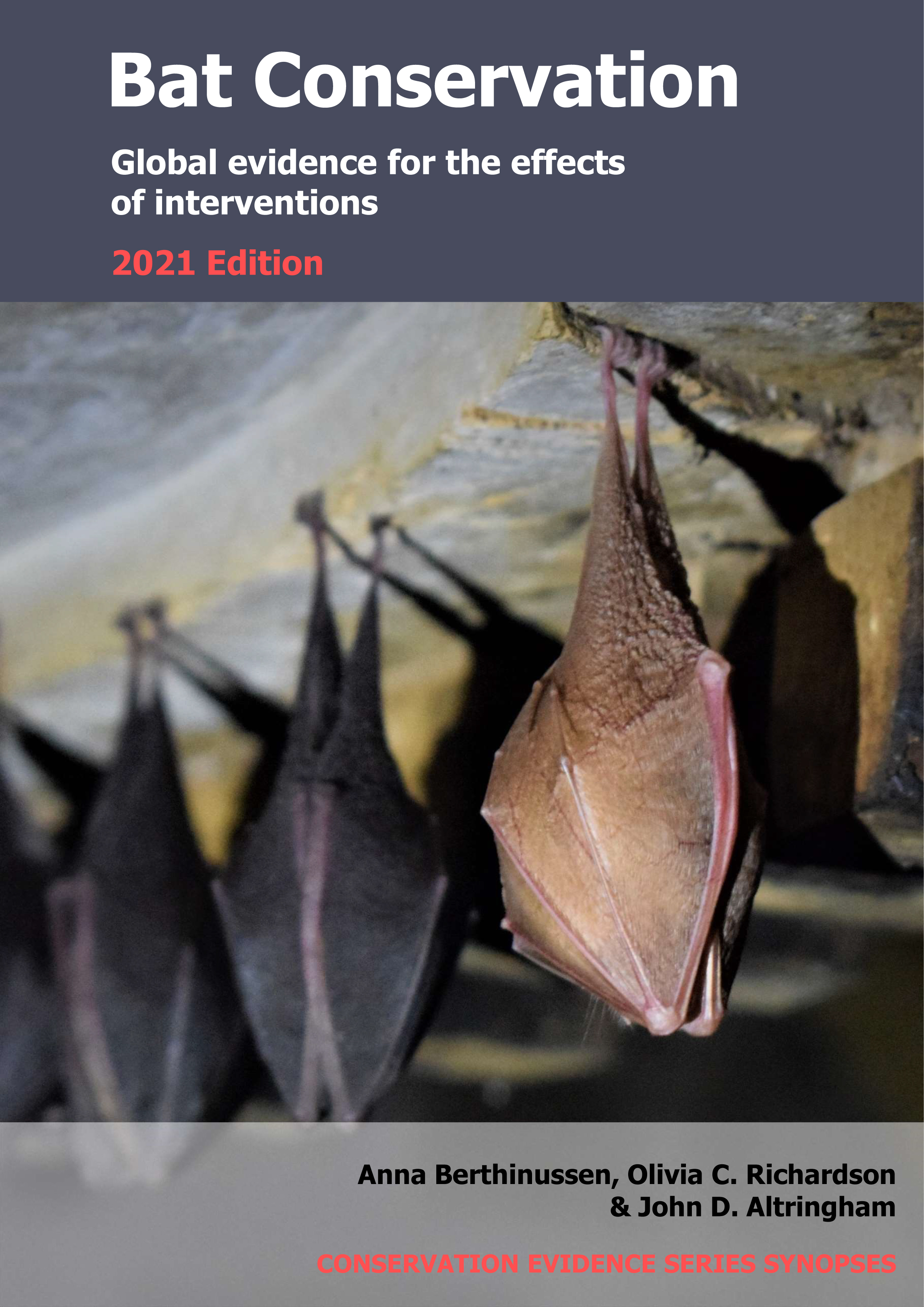Actions to conserve biodiversity
We have summarised evidence from the scientific literature about the effects of actions to conserve wildlife and ecosystems.
Review the evidence from the studies
Not sure what Actions are? Read a brief description.
Search for evidence
e.g. "frogs chytrid"
200 Actions found
Refine
Hide
200 Actions found
Download Actions
| 0 selected |
|
Order results by:
| Action | Effectiveness | Studies | Category | |
|---|---|---|---|---|
|
Maintain bat roosts in road/railway bridges and culverts Action Link |
Likely to be beneficial | 2 |
|
|
|
Create spaces for roosting bats in road/railway bridges and culverts Action Link |
Likely to be beneficial | 1 |
|
|
|
Deter bats from roads/railways using ultrasound Action Link |
No evidence found (no assessment) | 0 |
|
|
|
Minimize road lighting to reduce insect attraction Action Link |
No evidence found (no assessment) | 0 |
|
|
|
Avoid planting fruit trees alongside roads/railways in areas with fruit bats Action Link |
No evidence found (no assessment) | 0 |
|
|
|
Enforce regulations to prevent trafficking and trade of bats Action Link |
No evidence found (no assessment) | 0 |
|
|
|
Strengthen cultural traditions that discourage bat harvesting Action Link |
No evidence found (no assessment) | 0 |
|
|
|
Inform local communities about the negative impacts of bat hunting to reduce killing of bats Action Link |
Unknown effectiveness (limited evidence) | 1 |
|
|
|
Inform local communities about disease risks from hunting and eating bat meat to reduce killing of bats Action Link |
Unknown effectiveness (limited evidence) | 1 |
|
|
|
Introduce alternative treatments to reduce the use of bats in traditional medicine Action Link |
No evidence found (no assessment) | 0 |
|
|
|
Introduce other food sources to replace bat meat Action Link |
No evidence found (no assessment) | 0 |
|
|
|
Introduce other income sources to replace bat trade Action Link |
No evidence found (no assessment) | 0 |
|
|
|
Encourage online vendors to remove bat specimens for sale Action Link |
No evidence found (no assessment) | 0 |
|
|
|
Replace culling of bats with non-lethal methods of preventing vampire bats from spreading rabies to humans Action Link |
No evidence found (no assessment) | 0 |
|
|
|
Restrict the collection of bat specimens for research Action Link |
No evidence found (no assessment) | 0 |
|
|
|
Train arborists and forestry operatives to identify potential bat roosts Action Link |
No evidence found (no assessment) | 0 |
|
|
|
Protect roost trees during forest operations Action Link |
No evidence found (no assessment) | 0 |
|
|
|
Retain buffers around roost trees in logged areas Action Link |
No evidence found (no assessment) | 0 |
|
|
|
Change timing of forestry operations Action Link |
No evidence found (no assessment) | 0 |
|
|
|
Retain riparian buffers in logged areas Action Link |
No evidence found (no assessment) | 0 |
|
|
|
Manage forest and woodland to encourage understorey growth Action Link |
Unknown effectiveness (limited evidence) | 1 |
|
|
|
Coppice woodland Action Link |
No evidence found (no assessment) | 0 |
|
|
|
Encourage natural regeneration in former plantations Action Link |
No evidence found (no assessment) | 0 |
|
|
|
Strengthen cultural traditions such as sacred groves that prevent timber harvesting Action Link |
No evidence found (no assessment) | 0 |
|
|
|
Retain bat access points to caves Action Link |
No evidence found (no assessment) | 0 |
|
Download Actions
| 0 selected |
|

Bat Conservation - Published 2021
Update 2020
Watch this search
If you are familiar with RSS feeds, please click the button below to retrieve the feed URL:
RSS feed for this searchIf you are unfamiliar with RSS feeds, we would suggest reading this BBC article.
Unfortunately, due to the number of feeds we have available, we cannot provide e-mail updates. However, you could use tools such as Feed My Inbox to do this for you.
What are 'Individual studies' and 'Actions'?
Individual studies
An individual study is a summary of a specific scientific study, usually taken from a scientific journal, but also from other resources such as reports. It tells you the background context, the action(s) taken and their consequences.
If you want more detail please look at the original reference.
Actions
Each action page focuses on a particular action you could take to benefit wildlife or ecosystems.
It contains brief (150-200 word) descriptions of relevant studies (context, action(s) taken and their consequences) and one or more key messages.
Key messages show the extent and main conclusions of the available evidence. Using links within key messages, you can look at the paragraphs describing each study to get more detail. Each paragraph allows you to assess the quality of the evidence and how relevant it is to your situation.
Where we found no evidence, we have been unable to assess whether or not an intervention is effective or has any harmful impacts.





)_2023.JPG)














